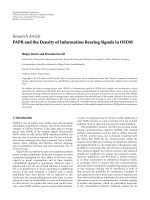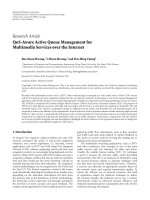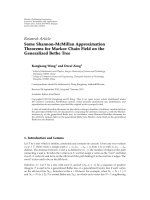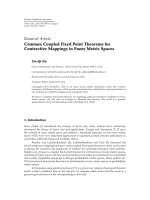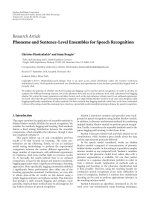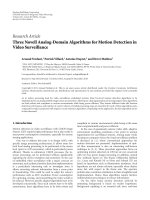Báo cáo hóa học: " Research Article Weak and Strong Convergence Theorems for Nonexpansive Mappings in Banach Spaces" pot
Bạn đang xem bản rút gọn của tài liệu. Xem và tải ngay bản đầy đủ của tài liệu tại đây (466.75 KB, 7 trang )
Hindawi Publishing Corporation
Fixed Point Theory and Applications
Volume 2008, Article ID 751383, 7 pages
doi:10.1155/2008/751383
Research Article
Weak and Strong Convergence Theorems for
Nonexpansive Mappings in Banach Spaces
Jing Zhao,
1
Songnian He,
1
and Yongfu Su
2
1
College of Science, Civil Aviation University of China, Tianjin 300300, China
2
Department of Mathematics, Tianjin Polytechnic University, Tianjin 300160, China
Correspondence should be addressed to Jing Zhao,
Received 25 August 2007; Accepted 16 December 2007
Recommended by Tomonari Suzuki
The purpose of this paper is to introduce two implicit iteration schemes for approximating fixed
points of nonexpansive mapping T and a finite family of nonexpansive mappings {T
i
}
N
i1
,respec-
tively, in Banach spaces and to prove weak and strong convergence theorems. The results presented
in this paper improve and extend the corresponding ones of H K. Xu and R. Ori, 2001, Z. Opial,
1967, and others.
Copyright q 2008 Jing Zhao et al. This is an open access article distributed under the Creative
Commons Attribution License, which p ermits unrestricted use, distribution, and reproduction in
any medium, provided the original work is properly cited.
1. Introduction and preliminaries
Let E be a real Banach space, K a nonempty closed convex subset of E,andT : K → K a
mapping. We use FT to denote the set of fixed points of T,thatis,FT{x ∈ K : Tx x}.
T is called nonexpansive if Tx − Ty≤x − y for all x, y ∈ K. In this paper, and → denote
weak and strong convergence, respectively.
coA denotes the closed convex hull of A,where
A is a subset of E.
In 2001, Xu and Ori 1 introduced the following implicit iteration scheme for common
fixed points of a finite family of nonexpansive mappings {T
i
}
N
i1
in Hilbert spaces:
x
n
α
n
x
n−1
1 − α
n
T
n
x
n
,n≥ 1, 1.1
where T
n
T
n mod N
, and they proved weak convergence theorem.
In this paper, we introduce a new implicit iteration scheme:
x
n
α
n
x
n−1
β
n
Tx
n−1
γ
n
Tx
n
,n≥ 1, 1.2
2 Fixed Point Theory and Applications
for fixed points of nonexpansive mapping T in Banach space and also prove weak and strong
convergence theorems. Moreover, we introduce an implicit iteration scheme:
x
n
α
n
x
n−1
β
n
T
n
x
n−1
γ
n
T
n
x
n
,n≥ 1, 1.3
where T
n
T
n mod N
, for common fixed points of a finite family of nonexpansive mappings
{T
i
}
N
i1
in Banach spaces and also prove weak and strong convergence theorems.
Observe that if K is a nonempty closed convex subset of a real Banach space E and
T : K → K is a nonexpansive mapping, then for every u ∈ K, α, β, γ ∈ 0, 1, and positive
integer n, the operator S S
α,β,γ,n
: K → K defined by
Sx αu βTu γTx 1.4
satisfies
Sx − Sy γTx− γTy≤γx − y 1.5
for all x, y ∈ K. Thus, if γ<1thenS is a contractive mapping. Then S has a unique fixed
point x
∗
∈ K. This implies that, if γ
n
< 1, the implicit iteration scheme 1.2 and 1.3 can be
employed for the approximation of fixed points of nonexpansive mapping and common fixed
points of a finite family of nonexpansive mappings, respectively.
Now, we give some definitions and lemmas for our main results.
A Banach space E is said to satisfy Opial’s condition if, for any {x
n
}⊂E with x
n
x∈ E,
the following inequality holds:
lim sup
n→∞
x
n
− x
< lim sup
n→∞
x
n
− y
, ∀y ∈ E, x
/
y. 1.6
Let D be a closed subset of a real Banach space E and let T : D → D be a mapping.
T is said to be demiclosed at zero if Tx
0
0 whenever {x
n
}⊂D, x
n
x
0
and Tx
n
→ 0.
T is said to be semicompact if, for any bounded sequence {x
n
}⊂D with lim
n→∞
x
n
−
Tx
n
0, there exists a subsequence {x
n
k
}⊂{x
n
} such that {x
n
k
} converges strongly to x
∗
∈ D.
Lemma 1.1 see 2, 3. Let E be a uniformly convex Banach space, let K be a nonempty closed convex
subset of E, and let T : K → K be a nonexpansive mapping. Then I − T is demiclosed at zero.
Lemma 1.2 see 4. Let E be a uniformly convex Banach space and let a, b be two constants with
0 <a<b<1. Suppose that {t
n
}⊂a, b is a real sequence and {x
n
}, {y
n
} are two sequences in E.
Then the conditions
lim
n→∞
t
n
x
n
1 − t
n
y
n
d, lim sup
n→∞
x
n
≤ d, lim sup
n→∞
y
n
≤ d 1.7
imply that lim
n→∞
x
n
− y
n
0,whered ≥ 0 is a constant.
2. Main results
Theorem 2.1. Let E be a real uniformly convex Banach space which satisfies Opial’s condition, let K be
a nonempty closed convex subset of E, and let T : K → K be a nonexpansive mapping with nonempty
fixed points set F.Let{α
n
}, {β
n
}, {γ
n
} be three real sequences in 0, 1 satisfying α
n
β
n
γ
n
1 and
0 <a≤ γ
n
≤ b<1,wherea, b are some constants. Then implicit iteration process {x
n
} defined by 1.2
converges weakly to a fixed point of T.
Jing Zhao et al. 3
Proof. Firstly, the condition of Theorem 2.1 implies γ
n
< 1, so that 1.2 can be employed for the
approximation of fixed point of nonexpansive mapping.
For any given p ∈ F,wehave
x
n
− p
α
n
x
n−1
β
n
Tx
n−1
γ
n
Tx
n
− p
α
n
x
n−1
− p
β
n
Tx
n−1
− p
γ
n
Tx
n
− p
≤ α
n
x
n−1
− p
β
n
Tx
n−1
− p
γ
n
Tx
n
− p
≤
α
n
β
n
x
n−1
− p
γ
n
x
n
− p
2.1
which leads to
1 − γ
n
x
n
− p
≤
α
n
β
n
x
n−1
− p
1 − γ
n
x
n−1
− p
. 2.2
It follows from the condition γ
n
≤ b<1that
x
n
− p
≤
x
n−1
− p
. 2.3
Thus lim
n→∞
x
n
− p exists, a nd so let
lim
n→∞
x
n
− p
d. 2.4
Hence {x
n
} is a bounded sequence. Moreover, co{x
n
} is a bounded closed convex subset of
K.Wehave
lim
n→∞
x
n
− p
lim
n→∞
α
n
x
n−1
− p
β
n
Tx
n−1
− p
γ
n
Tx
n
− p
lim
n→∞
1 − γ
n
α
n
1 − γ
n
x
n−1
− p
β
n
1 − γ
n
Tx
n−1
− p
γ
n
Tx
n
− p
t d,
lim sup
n→∞
Tx
n
− p
≤ lim sup
n→∞
x
n
− p
d.
2.5
Again, it follows from the condition α
n
β
n
γ
n
1that
lim sup
n→∞
α
n
1 − γ
n
x
n−1
− p
β
n
1 − γ
n
Tx
n−1
− p
≤ lim sup
n→∞
α
n
1 − γ
n
x
n−1
− p
β
n
1 − γ
n
Tx
n−1
− p
≤ lim sup
n→∞
α
n
β
n
1 − γ
n
x
n−1
− p
d.
2.6
By Lemma 1.2, the condition 0 <a≤ γ
n
≤ b<1, and 2.5–2.6,weget
lim
n→∞
α
n
1 − γ
n
x
n−1
− p
β
n
1 − γ
n
Tx
n−1
− p
−
Tx
n
− p
0. 2.7
4 Fixed Point Theory and Applications
This means that
lim
n→∞
α
n
1 − γ
n
x
n−1
β
n
1 − γ
n
Tx
n−1
− Tx
n
lim
n→∞
1
1 − γ
n
α
n
x
n−1
β
n
Tx
n−1
−
1 − γ
n
Tx
n
0.
2.8
Since 0 <a≤ γ
n
≤ b<1, we have 1/1 − a ≤ 1/1 − γ
n
≤ 1/1 − b. Hence,
lim
n→∞
α
n
x
n−1
β
n
Tx
n−1
−
1 − γ
n
Tx
n
0. 2.9
Because
lim
n→∞
α
n
x
n−1
β
n
Tx
n−1
−
1 − γ
n
Tx
n
lim
n→∞
x
n
− γ
n
Tx
n
−
1 − γ
n
Tx
n
lim
n→∞
x
n
− Tx
n
,
2.10
by 2.9,weget
lim
n→∞
x
n
− Tx
n
0. 2.11
Since E is uniformly convex, every bounded closed convex subset of E is weakly com-
pact, so that there exists a subsequence {x
n
k
} of sequence {x
n
}⊆co{x
n
} such that x
n
k
q∈
K. Therefore, it follows from 2.11 that
lim
k→∞
Tx
n
k
− x
n
k
0. 2.12
By Lemma 1.1, we know that I − T is demiclosed at zero; it is esay to see that q ∈ F.
Now, we show that x
n
q. In fact, this is not true; then there must exist a subsequence
{x
n
i
}⊂{x
n
} such that x
n
i
q
1
∈ K, q
1
/
q. Then, by the same method given above, we can also
prove that q
1
∈ F.
Because, for any p ∈ F, the limit lim
n→∞
x
n
− p exists. Then we can let
lim
n→∞
x
n
− q
d
1
, lim
n→∞
x
n
− q
1
d
2
. 2.13
Since E satisfies Opial’s condition, we have
d
1
lim sup
k→∞
x
n
k
− q
< lim sup
k→∞
x
n
k
− q
1
d
2
,
d
2
lim sup
i→∞
x
n
i
− q
1
< lim sup
i→∞
x
n
i
− q
d
1
.
2.14
This is a contradiction and hence q q
1
. This implies that {x
n
} converges weakly to a fixed
point q of T. This completes the proof.
From the proof of Theorem 2.1, we give the following strong convergence theorem.
Theorem 2.2. Let E be a real uniformly convex Banach space, let K be a nonempty closed convex
subset of E,letT : K → K be a nonexpansive mapping with nonempty fixed points set F, and let T
be semicompact. Let {α
n
}, {β
n
}, {γ
n
} be three real sequences in 0, 1 satisfying α
n
β
n
γ
n
1 and
0 <a≤ γ
n
≤ b<1,wherea, b are some constants. Then implicit iteration process {x
n
} defined by 1.2
converges strongly to a fixed point of T.
Jing Zhao et al. 5
Proof. From the proof of Theorem 2.1, we know that there exists subsequence {x
n
k
}⊂{x
n
}
such that x
n
k
q∈ K and satisfies 2.11. By the semicompactness of T, there exists a subse-
quence of {x
n
k
} we still denote it by {x
n
k
} such that lim
n→∞
x
n
k
− q 0. Because the limit
lim
n→∞
x
n
− q exists, thus we get lim
n→∞
x
n
− q 0. This completes the proof.
Next, we study weak and strong convergence theorems for common fixed points of a
finite family of nonexpansive mappings {T
i
}
N
i1
in Banach spaces.
Theorem 2.3. Let E be a real uniformly convex Banach space which satisfies Opial’s condition, let K
be a nonempty closed convex subset of E, and let {T
i
}
N
i1
: K → K be N nonexpansive mappings with
nonempty common fixed points set F.Let{α
n
}, {β
n
}, {γ
n
} be three real sequences in 0, 1 satisfying
α
n
β
n
γ
n
1, 0 <a≤ γ
n
≤ b<1,andα
n
− β
n
>c>0,wherea, b, c are some constants. Then
implicit iteration process {x
n
} defined by 1.3 converges weakly to a common fixed point of {T
i
}
N
i1
.
Proof. Substituing T
i
1 ≤ i ≤ N to T in the proof of Theorem 2.1, we know that for all i
1 ≤ i ≤ N,
lim
n→∞
x
n
− T
n
x
n
0. 2.15
Now we show that, for any l 1, 2, ,N,
lim
n→∞
x
n
− T
l
x
n
0. 2.16
In fact,
x
n
− x
n−1
β
n
T
n
x
n−1
γ
n
T
n
x
n
−
β
n
γ
n
x
n−1
β
n
T
n
x
n−1
− β
n
x
n
γ
n
T
n
x
n
− γ
n
x
n
β
n
γ
n
x
n
− x
n−1
≤ β
n
T
n
x
n−1
− x
n
γ
n
T
n
x
n
− x
n
β
n
γ
n
x
n
− x
n−1
≤ β
n
T
n
x
n−1
− T
n
x
n
β
n
T
n
x
n
− x
n
γ
n
T
n
x
n
− x
n
β
n
γ
n
x
n
− x
n−1
≤
β
n
γ
n
T
n
x
n
− x
n
2β
n
γ
n
x
n
− x
n−1
β
n
γ
n
T
n
x
n
− x
n
β
n
1 − α
n
x
n
− x
n−1
.
2.17
By removing the second term on the right of the above inequality to the left, we get
α
n
− β
n
x
n
− x
n−1
≤
β
n
γ
n
T
n
x
n
− x
n
. 2.18
It follows from the condition α
n
− β
n
>c>0and2.15 that
lim
n→∞
x
n
− x
n−1
0. 2.19
So, for any i 1, 2, ,N,
lim
n→∞
x
n
− x
ni
0. 2.20
6 Fixed Point Theory and Applications
Since, for any i 1, 2, 3, ,N,
x
n
− T
ni
x
n
≤
x
n
− x
ni
x
ni
− T
ni
x
ni
T
ni
x
ni
− T
ni
x
n
≤ 2
x
n
− x
ni
x
ni
− T
ni
x
ni
,
2.21
it follows from 2.15 and 2.20 that
lim
n→∞
T
ni
x
n
− x
n
0,i 1, 2, 3, ,N. 2.22
Because T
n
T
n mod N
, it is easy to see, for any l 1, 2, 3, ,N,that
lim
n→∞
T
l
x
n
− x
n
0. 2.23
Since E is uniformly convex, so there exists a subsequence {x
n
k
} of bounded sequence {x
n
}
such that x
n
k
q∈ K. Therefore, it follows from 2.23 that
lim
k→∞
T
l
x
n
k
− x
n
k
0, ∀ l 1, 2, 3, ,N. 2.24
By Lemma 1.1, we know that I − T
l
is demiclosed, it is easy to see that q ∈ FT
l
,sothatq ∈ F
N
l1
FT
l
. Because E satisfies Opial’s condition, we can prove that {x
n
} converges weakly to a
common fixed point q of {T
l
}
N
l1
by the same method given in the proof of Theorem 2.1.
Remark 2.4. If N 1, implicit iteration scheme 1.3 becomes 1.2,sofromTheorem 2.1,we
know that assumption α
n
− β
n
>c>0inTheorem 2.3 can be removed.
Theorem 2.5. Let E be a real uniformly convex Banach space, let K be a nonempty closed convex subset
of E,let{T
i
}
N
i1
: K → K be N nonexpansive mappings with nonempty common fixed points set F,
and there exists an l ∈{1, 2, ,N} such that T
l
is semicompact. Let {α
n
}, {β
n
}, {γ
n
} be three real
sequences in 0, 1 satisfying α
n
β
n
γ
n
1, 0 <a≤ γ
n
≤ b<1,andα
n
− β
n
>c>0,wherea,
b , c are some constants. Then implicit iteration process {x
n
} defined by 1.3 converges strongly to a
common fixed point of {T
i
}
N
i1
.
Proof. From the proof of Theorem 2.3, we know that there exists subsequence {x
n
k
}⊂{x
n
} such
that {x
n
k
} converges w eakly to some q ∈ K and satisfies 2.23. By the semicompactness of T
l
,
there exists a subsequence of {x
n
k
} we still denote it by {x
n
k
} such that lim
n→∞
x
n
k
− q 0.
Because the limit lim
n→∞
x
n
− q exists, thus we get lim
n→∞
x
n
− q 0. This completes the
proof.
Acknowledgment
This research is supported by Tianjin Natural Science Foundation in China Grant no.
06YFJMJC12500.
Jing Zhao et al. 7
References
1 H K. Xu and R. G. Ori, “An implicit iteration process for nonexpansive mappings,” Numerical Func-
tional Analysis and Optimization, vol. 22, no. 5-6, pp. 767–773, 2001.
2 H. H. Bauschke, “The approximation of fixed points of compositions of nonexpansive mappings in
Hilbert space,” Journal of Mathematical Analysis and Applications, vol. 202, no. 1, pp. 150–159, 1996.
3 J. G
´
ornicki, “Weak convergence theorems for asymptotically nonexpansive mappings in uniformly con-
vex Banach spaces,” Commentationes Mathematicae Universitatis Carolinae, vol. 30, no. 2, pp. 249–252,
1989.
4 J. Schu, “Weak and strong convergence to fixed points of asymptotically nonexpansive mappings,”
Bulletin of the Australian Mathematical Society, vol. 43, no. 1, pp. 153–159, 1991.


